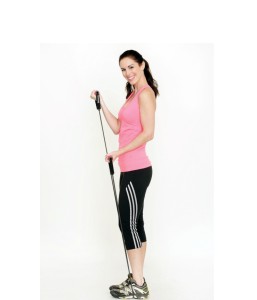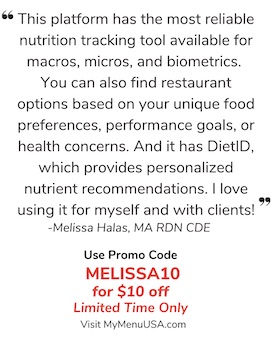
I’ve debunked fitness myths for you before, and now I’m ready to do it again! Here are seven more common fitness myths we hear all the time, and what you should really believe instead:
- You need to have a protein bar or protein drink after a workout. There are plenty of alternative and often-healthier post-workout snacks if you’re hungry. Only competitive athletes need to eat right after a work-out! For elite athletes, it’s important to consume a meal or snack that contains both carbohydrates and protein. Carbohydrates help restore glycogen stores, while the protein helps repair muscles. But for standard cardio, weight lifting or even a 2-hour hike, you may be able to hold off until your next meal unless you’re truly hungry. Adding snacks after a work-out, especially for individuals who struggle maintaining their weight is often unnecessary. For example, if I’ve had a challenging work-out (1 hour of heavy weight lifting with 30 minutes of cardio or a 2-hour hike with hills, I’ll typically follow it up with a healthy meal that is high in lean protein. But that meal may not be for an hour or two. This could be two eggs and several eggs whites, a slice of whole-grain toast with lots of vegetables and a side of fruit. If it’s in between meals, my breakfast was light and I’m truly hungry I may choose a protein shake without additives or supplements, but that’s because I eat a mostly vegetarian diet. I like BioChem Organic Whey which is healthier than many protein bars! I mix this with 6 oz of water, 2-4 ounces of organic soy milk, lots of ice, a half of a frozen banana, vanilla extract and a teaspoon of honey. Protein shakes and bars can be an option on the go, but whole-food options like a hard boiled egg and veggies with hummus are also great. Simple staples like milk, Greek yogurt and fruit or a peanut butter and banana sandwich also work well. But no need to force it! If you’re not hungry, and you’re not training very hard, it is fine to wait until your next meal to eat.
- No pain, no gain. Exercise should be tough, but it should not be painful. If you are experiencing pain during a workout, double check your form or go light on the moves that are uncomfortable. Remember, better safe than sorry. The last thing you want to do is stress a joint or pull a muscle from overuse or improper form. Always listen to your body and stop if you feel physical pain.
- Weight machines are better than free weight. Both have pros and cons, depending on the individual and their training goals. Weight machines can make it easier to work awkward muscles, like your hip abductors, but free weights are great for convenient at-home workouts. Try using both throughout the week to prevent workout boredom. I’m partial to Pilates—if you have a history of neck or back injuries it helps keep everything properly aligned. You can work all your major muscle groups and adjust the resistance with the springs.
- You can make up for not working out during the weekdays by going hard on the weekends. Nope! It’s like cramming for an exam. You’re much better off doing a little each day but include a day or rest. This gives your muscles more time to repair themselves after each workout and helps prevent injury from overuse. For exercise enthusiast, Try not to stress if you can’t fit in a 60-minute sweat session each day. Even just twenty minutes of high-quality exercise can really add up.
- You need to have a gym membership to get a complete workout. This myth is definitely false! There are so many other ways to get physically active. Try taking a walk, hiking, biking, or even just climbing the stairs of your office building. Perform body weight exercises at home, like push-ups, squats, lunges, and planks, for a great workout—no equipment needed! Invest in some resistance bands for strength training at home. I encourage pretty much anyone who is not exercising to do chair exercises. These are a form of squats. Using a chair you start to sit down, but just shy of your rump touching the chair you stand up again. Even if you work out regularly these are great to do through out the day if you have a desk job. My 80-year-old aunt does 100 chairs. So work your way up to that! Check out these new, old, odd and fad fitness routines for more ideas.
- Running is the best way to lose weight. The truth is, there are many other effective options to burn calories –find what you love and stick with it. Walking, hiking, cycling, and swimming are all fabulous alternatives. The key is finding something you love so you’ll stick with it and make it part of your weekly routine. My work out routine for resistance training is 2 days a week for each of these groups: legs, biceps, tripceps, shoulders and core and chest, backs and abs. Usually, these take 60 minutes. Then I do cardio, which varies from 20 minutes to 60 minutes 3-4 days a week. I try to hike 2-3 times a month for 90 minutes. Having a history of a broken back and neck injury, I really can’t afford to skimp on exercising. It’s essential for pain management and will keep me strong for life to maintain a healthy spine.
- You need a lot of equipment to get a full workout. Nature is free, and there are countless exercises you can do using just your body weight. Hop on the internet and find a new video work-out routine a new trail to hike, or running, or a set of stairs in your area. Make a workout date with a friend to make exercise fun and sociable. Or find a social accountability partner who you can report to on the days you work –out. You’ll be much more likely to stick to it!
Never fall for these silly fitness myths again. Remember, extreme claims or things that sound too good to be true are probably just that. Be consistent and stick with exercise you enjoy, and you’ll be well on your way to feeling great in your body.



